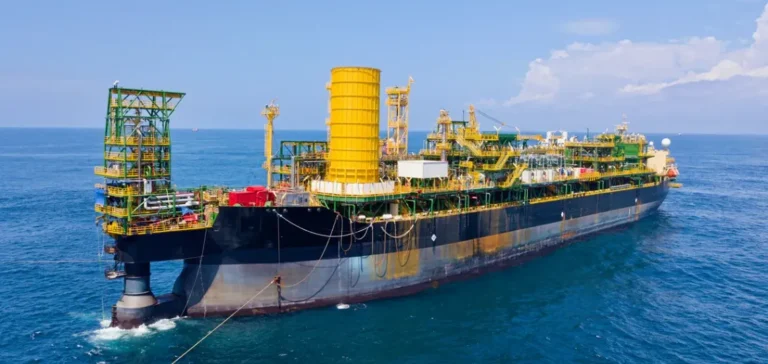The competition for offshore industrial resources has become the central determinant of Namibia’s oil timeline. The availability of FPSOs and next-generation drillships now shapes investment decisions, drilling windows, and production sequencing. In this context, the trade-off between additional exploration campaigns, associated gas management, and securing shipyard capacity weighs as heavily as subsurface potential. Operators must integrate these constraints from the design stage of development schemes, without promotional assumptions, but based on available costs and schedules.
Resumption of exploration and sequencing realignment
Shell has announced preparations for a new exploration campaign on PEL 39 with drilling starting in 2026, alongside QatarEnergy and NAMCOR. This outlook follows several discoveries and is part of an ongoing assessment of the Orange Basin’s potential. The stakes in PEL 39 are 45% for Shell (operator), 45% for QatarEnergy, and 10% for NAMCOR.
The immediate environment remains constrained by a write-down of approximately $400 million on PEL 39. The identified technical challenges involve fluid mobility, permeability, and a high GOR—factors that complicate the economic viability of development. These elements are key parameters in prioritizing upcoming work.
Cost parameter: operator demands on investment thresholds
For TotalEnergies, the final investment decision (FID) on the Venus project remains conditional on achieving a target unit cost. The company aims for a threshold below $20 per barrel to approve the next phase, with FID expected in 2026. The combination of ultra-deepwater and high GOR requires a development scheme capable of meeting this objective.
FPSO availability represents a global bottleneck, with a heavy concentration of orders in South America. The order book for large-capacity units absorbs a significant share of available shipyard slots, extending lead times and increasing costs for other emerging basins.
Time parameter: high dayrates for deepwater rigs
The deepwater drilling segment is characterized by high dayrates for sixth- and seventh-generation drillships. Estimates for 2025 place daily rates between $400,000 and over $500,000, with some cases exceeding $600,000 in tight markets. Access to available vessels at the right time becomes a decisive variable for multi-well campaigns.
These cost levels, combined with campaign durations and logistical requirements (support vessels, subsea equipment, completion units), encourage operators to pool programs or smooth out sequencing over time. Namibia’s sequencing must contend with trade-offs being made in other areas such as the Gulf of Mexico, South America, or West Africa, where demand remains strong.
Fiscal framework and local content: financial balance parameters
Namibia’s fiscal framework is based on a tax-royalty regime combining a 35% Petroleum Income Tax, a tiered Additional Profits Tax based on returns, and royalties. Project viability depends both on technical costs and tax structure.
Local content is subject to a dedicated policy aimed at strengthening national participation and developing a domestic supply chain. Authorities have expressed their ambition to increase the state’s stake via NAMCOR and to mandate local content thresholds in development plans. These requirements add regulatory milestones to be integrated from the planning phase.
First oil target and competing trajectories
Authorities have confirmed a target of first oil by 2030, a milestone that coexists with various industrial benchmarks. Venus is often identified as the potential pilot project, pending FID and compliance with cost thresholds. Negative discoveries elsewhere in the country do not undermine this trajectory but reinforce the emphasis on target quality and financial discipline.
On PEL 85, Rhino Resources and Azule Energy are progressing on an accelerated timeline, with drilling underway and a production target around 2030. The partnership includes an option for Azule to operate the development, which could enable a pooling of technical expertise. The existence of parallel trajectories increases pressure on shared industrial resources (rigs, FPSOs, subsea equipment).
Gas dimension: reinjection, processing, and commercialization pathways
The management of associated gas remains a central issue. High GOR and ultra-deepwater conditions lead projects toward schemes favoring gas reinjection—at least initially—to contain costs and avoid premature investment in evacuation infrastructure. This parameter directly affects FPSO sizing, compressor management, and the production profile.
Gas commercialization (domestic electricity, FLNG) remains undefined. For now, technical decisions focus on controlling unit costs rather than opening commercial outlets. Choices related to the gas midstream chain introduce additional uncertainty regarding scheduling and engineering specifications.
Asset movements and M&A: Mopane as an adjustment variable
On PEL 83, Galp Energia is continuing the assessment of the Mopane complex with an extended campaign and a process aimed at bringing in an operating partner for a multi-FPSO development. Initial estimates point to a potential of several billion barrels of oil equivalent in place, with volumes recently confirmed and a partial divestment strategy underway.
This move creates a ripple effect: the arrival of a major on Mopane could accelerate decisions on fleets (drillships, FPSOs) and indirectly influence the capacity available for other licenses. The interest of supermajors in operated positions in Namibia is growing in a global context where large deepwater basins are becoming scarce.






















